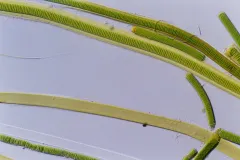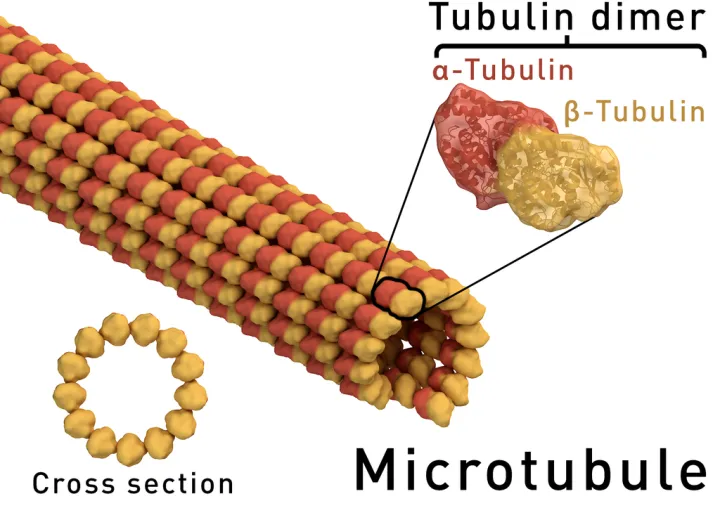A Cancer Fighter from the Sea

The medicine cabinet may seem like a mysterious treasure trove of pills that cure innumerable pains and sicknesses, but the power behind many of our most common and important medicinal drugs comes from nature. Cold-curing Sudafed comes from compounds in the Ephedra sinica plant, pain-relieving aspirin originates from willow bark, and the remarkable antibacterial properties of penicillin were discovered in Penicillium mold. An array of cancer treatments come from nature, both land and sea. Now a newly discovered compound found in an ocean bacterium may join the list of potential cancer-fighting drugs.
Cancer is an overarching term for when cell growth in the body goes awry, which often leads to the growth of a cell mass, known as a tumor. The growth of a tumor can happen for many reasons, which is why cancer can be such so difficult to treat. Cells multiply through the process of cell division—the splitting of one cell into two—and in cancer, cell division occurs at an unchecked pace. Stopping that unchecked cell division can be key to ending a cancer’s growth and many currently available drugs do just that. This is where our ocean bacterium comes into play.
Scientists have recently found a remarkable compound made by cyanobacteria, common bacteria in the ocean that are famous for their ability to produce oxygen through photosynthesis. The recently discovered compound, named gatorbulin-1, interferes with cell division by hindering the cell machinery that carries out the duplicating process.
Like many marine bacteria and algae, cyanobacteria produce dozens of compounds meant to deter predators, survive unpredictable weather, and avoid infection, among other purposes. While studying various species of cyanobacteria, Smithsonian scientist Dr. Valerie Paul and her colleague Dr. Hendrik Luesch were blown away by the variety and number of compounds that this type of bacteria produced. They knew that several of them could have applications beyond their role in the natural environment.
“There’s a whole rich history of the use of plant materials and a lot of knowledge about natural products being really important,” says Paul. “By looking at marine organisms we can access a whole new suite of potential compounds that are from organisms that have undergone completely different evolutionary pressures over time, so you can find a whole suite of things in the ocean that we never even dreamed of.”
The first task was isolating the various compounds from complex mixtures, removing them completely from everything else in the cell. Once that was completed, Luesch determined the chemical structures and added each prospective compound, including gatorbulin-1, to cancer cells and normal cells and watched to see what happened. When the cancer cells exposed to gatorbulin-1 were selectively inhibited, the team knew they had a potentially promising anticancer treatment. Through further investigation into the chemistry of the compound it became clear why.
Specifically, gatorbulin-1 prevents the proper construction of cell structures called microtubules. Hollowed tubes built of spherical building blocks, microtubules look and function like cables and serve many functions within and around the cell. In some instances, microtubules act as highways, serving as structures that move important material across the cell. During cell division they are the primary tool that pulls apart the cellular innards into two new cells.
Add gatorbulin-1 to the mix, and microtubule construction goes awry. Key components to microtubule construction are their building blocks, spherical molecules bound like two peanuts encased in a shell that layer one on top of another, consisting of α- and β-tubulin. The size and shape of the gatorbulin-1 fits perfectly in between the two bound spheres of the peanut, which then prevents proper assembly and function.
If microtubules are unable to form or are destabilized, the cell is unable to divide—there’s nothing to pull the duplicated cells in two. This is how many drugs that attach to tubulin work—they stop the microtubule growth which ultimately stops the cancer growth. However, in contrast to all other tubulin-targeting agents, gatorbulin-1 binds to a new tubulin site and therefore provides a new way to interfere with proper tubulin assembly.
Gatorbulin-1 joins several other compounds previously discovered to disrupt microtubule growth, and many of these compounds are already used as effective cancer treatments. Dolastatin 10, previously discovered by Luesch and Paul from marine cyanobacteria, served as the blueprint for the development of three FDA-approved drugs for various lymphomas and refractory bladder cancer, and like gatorbulin-1, disrupts the formation of microtubules. The hope is that this new molecule may reveal more effective drugs that prevent the growth of tumors in humans with lesser side effects.


